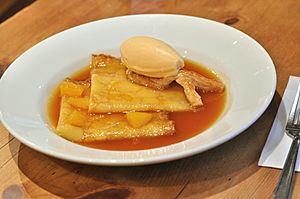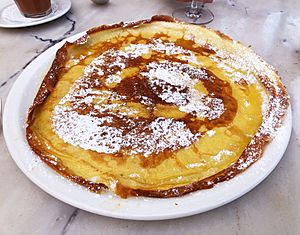Crêpes Suzette facts for kids
 |
|
| Course | Dessert |
|---|---|
| Place of origin | France |
| Main ingredients | Crêpes, beurre Suzette (caramelized sugar and butter, tangerine or orange juice, zest, Grand Marnier, triple sec or orange Curaçao liqueur) |
Crêpes Suzette is a famous French dessert. It features thin pancakes, called crêpes. These crêpes are covered in a special sauce called beurre Suzette.
This sauce is made from caramelized sugar and butter. It also includes juice and zest from tangerines or oranges. To make it extra special, orange-flavored liqueurs like Grand Marnier are added. Often, the dish is flambéed, meaning it's set on fire briefly at the table. This creates a dramatic effect and adds to the flavor.
Origins of Crêpes Suzette
The exact story of how Crêpes Suzette got its name is a bit of a mystery. There are two main stories about its creation. Both stories are interesting and involve famous people!
Henri Charpentier's Story
One popular story comes from a chef named Henri Charpentier. He wrote about it in his autobiography. In 1895, when he was just 14, he was working as a waiter's assistant. This was at the Café de Paris in Monte Carlo.
He was preparing a dessert for the Prince of Wales. This prince later became King Edward VII of the United Kingdom. A beautiful French girl named Suzette was also at the table. Henri accidentally set the liqueurs on fire while cooking. He thought he had ruined the dessert.
But when he tasted it, he found it was delicious! The flame had made the flavors even better. The Prince loved the pancakes. He asked Henri what they were called. Henri first called them "Crêpes Princesse" to honor the Prince. However, the Prince saw the lady Suzette. He then asked Henri to change the name to "Crêpes Suzette" instead. This is how, according to Henri, the famous dessert was named.
Some people, like the famous food guide Larousse Gastronomique, doubt this story. They think Henri might have been too young to be serving the prince directly. Another version of Henri's story suggests the dish was based on a pancake recipe his foster mother made. Adding liqueur was a common trend among chefs in Paris at that time.
Suzanne Reichenberg's Story
Another claim says the dish was named after a French actress. Her name was Suzanne Reichenberg (1853–1924). She was known professionally as Suzette. In 1897, she performed in a play. In her role, she served crêpes on stage.
Monsieur Joseph, who owned the Restaurant Marivaux, provided these crêpes. He decided to set the thin pancakes on fire. This was done to get the audience's attention. It also helped keep the food warm for the actors eating them. Monsieur Joseph later worked at famous restaurants in Paris and London.
Interestingly, early recipes for similar pancakes didn't always include the flambé part. In 1896, Oscar Tschirky published a recipe called "Pancakes, Casino Style." It was very similar but didn't mention setting them on fire. Even Escoffier, a very famous chef, described Crêpes Suzette in his 1907 cookbook without the final flambé.
By 1898, this dish was already a special item at a French restaurant called Marie's.
See also
 In Spanish: Crêpe Suzette para niños
In Spanish: Crêpe Suzette para niños


